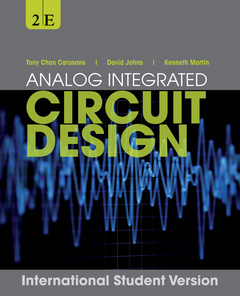Description
Analog integrated circuit design (2nd Ed., 2nd Edition International Student Version)
Authors: Carusone Tony Chan, Johns David, Martin Kenneth
Language: English
Approximative price 66.99 €
In Print (Delivery period: 14 days).
Add to cart792 p. · 18.8x23.5 cm · Paperback
Description
/li>Contents
/li>
1.1 Semiconductors and pn Junctions 1
1.2 MOS Transistors 14
1.3 Device Model Summary 38
1.4 Advanced MOS Modelling 42
1.5 SPICE Modelling Parameters 50
1.6 Passive Devices 54
1.7 Appendix 60
1.8 Key Points 68
1.9 References 69
1.10 Problems 69
Summary 70
Modelling Parameters 71
1.10.4 Section 1.6: Passive Devices 71
CHAPTER 2 PROCESSING AND LAYOUT 73
2.1 CMOS Processing 73
2.2 CMOS Layout and Design Rules 86
2.3 Variability 97
2.4 Analog Layout Considerations 104
2.5 Key Points 114
2.6 References 115
2.7 Problems 116
CHAPTER 3 BASIC CURRENT MIRRORS AND SINGLE-STAGE AMPLIFIERS 119
3.1 Simple CMOS Current Mirror 120
3.2 Common-Source Amplifier 122
3.3 Source-Follower or Common-Drain Amplifier 124
3.4 Common-Gate Amplifier 126
3.5 Source-Degenerated Current Mirrors 129
3.6 Cascode Current Mirrors 131
3.7 Cascode Gain Stage 137
3.8 MOS Differential Pair and Gain Stage 137
3.9 Key Points 140
3.10 References 141
3.11 Problems 141
CHAPTER 4 FREQUENCY RESPONSE OF ELECTRONIC CIRCUITS 146
4.1 Frequency Response of Linear Systems 146
4.2 Frequency Response of Elementary Transistor Circuits 167
4.3 Cascode Gain Stage 183
4.4 Source-Follower Amplifier 190
4.5 Differential Pair 196
4.6 Key Points 200
4.7 References 201
4.8 Problems 201
CHAPTER 5 FEEDBACK AMPLIFIERS 207
5.1 Ideal Model of Negative Feedback 207
5.2 Dynamic Response of Feedback Amplifiers 211
5.3 First- and Second-Order Feedback Systems 216
5.4 Common Feedback Amplifiers 224
5.5 Summary of Key Points 239
5.6 References 240
5.7 Problems 240
CHAPTER 6 BASIC OPAMP DESIGN AND COMPENSATION 246
6.1 Two-Stage CMOS Opamp 246
6.2 Opamp Compensation 258
6.3 Advanced Current Mirrors 265
6.4 Folded-Cascode Opamp 272
6.5 Current Mirror Opamp 279
6.6 Linear Settling Time Revisited 283
6.7 Fully Differential Opamps 285
6.8 Common-Mode Feedback Circuits 291
6.9 Summary of Key Points 295
6.10 References 296
6.11 Problems 297
CHAPTER 7 BIASING, REFERENCES, AND REGULATORS 305
7.1 Analog Integrated Circuit Biasing 305
7.2 Establishing Constant Transconductance 310
7.3 Establishing Constant Voltages and Currents 313
7.4 Voltage Regulation 324
7.5 Summary of Key Points 330
7.6 References 330
7.7 Problems 331
CHAPTER 8 BIPOLAR DEVICES AND CIRCUITS 334
8.1 Bipolar-Junction Transistors 334
8.4 Bipolar and BICMOS Processing 349
8.4.1 Bipolar Processing 349
8.5 Bipolar Current Mirrors and Gain Stages 352
8.6 Appendix 359
8.7 Summary of Key Points 362
8.8 References 363
8.9 Problems 363
CHAPTER 9 NOISE AND LINEARITY ANALYSIS AND MODELLING 367
9.1 Time-Domain Analysis 367
9.2 Frequency-Domain Analysis 371
9.3 Noise Models for Circuit Elements 381
9.3.8 Input-Referred Noise 388
9.4 Noise Analysis Examples 391
9.5 Dynamic Range Performance 401
9.6 Key Points 408
9.7 References 409
9.8 Problems 410
CHAPTER 10 COMPARATORS...




